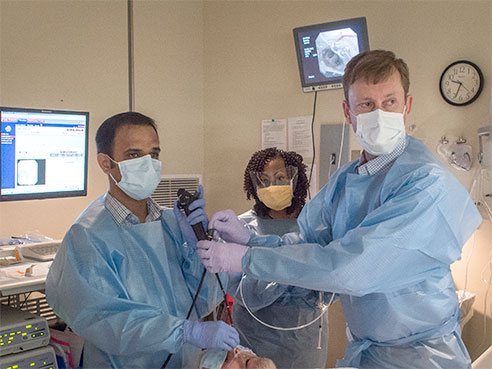A recent study of an endoscopic technique called flexible bronchoscopy (FB) in patients with chronic obstructive pulmonary disease (COPD) and pulmonary hypertension (PH) has found these patients have an elevated risk of lower blood-oxygen levels than COPD patients undergoing the procedure. The paper, titled “Increased hypoxemia in patients with COPD and pulmonary hypertension undergoing bronchoscopy with biopsy,” was published in the International Journal of COPD.
COPD is a characterized by inflamed airways resulting in poor airflow through the lungs, while PH, a complication often seen in patients with advanced COPD, is marked by elevated blood pressure in pulmonary artery/vein due to narrowing of the lung’s blood vessels. For diagnostic and therapeutic purposes, FB is useful to visualize the airways of COPD/PH patients and conduct a cleansing (lavage) or biopsy. The procedure is considered invasive and performed under anesthesia, but is generally effective, safe, and well-tolerated in patients with pulmonary diseases. Complications, like bleeding, cardiac dysrhythmias, hypoxia, and bronchospasm, are minimal in this group (0.5%–4%). However, studies have found a higher risk among PH patients, although substantiating data are lacking.
This study involved 207 COPD patients subjected to FB. The pulmonary artery pressure of all patients was evaluated by means of an echo-Doppler, a method based on ultrasound technology. The study’s primary goal was to determine the occurrence of PH among patients subjected to FB, and the secondary endpoint was the degree of complications found.
The team recorded normal pulmonary pressure in 167 COPD patients (80.7%), while the remaining 40 (19.3%) had differing degrees of PH: mild (27 patients, or 13.0%), moderate (8 patients, or 3.9%), and severe (5 patients, or 2.4%). The parameters related to circulatory blood through the cardiovascular (noninvasive hemodynamic) were found to be similar before and after FB among PH and non-PH patients. Complications related to cardiac arrhythmia arising from improper electrical activity of the heart (supraventricular tachycardia) were observed in two patients having normal pulmonary pressure. Other data showed no difference between groups in terms of bleeding during the FB (lavage/biopsy) procedure. However, PH patients subjected to FB (lavage/biopsy) showed reduced levels of oxygen saturation (hypoxemia) during the procedure compared to the non-PH group (23.5% versus 6.9%). None of the patients developed significant irregular heartbeats (dysrhythmia) and no deaths were recorded.
In summary, these findings highlight the prevalence and degree of PH among COPD patients, and the elevated risk to PH patients undergoing FB (lavage/biopsy) procedures because of the reduced oxygen levels measured in their blood. Future studies could reveal the risks of an FB procedure among COPD patients with varying degrees of disease severity.

